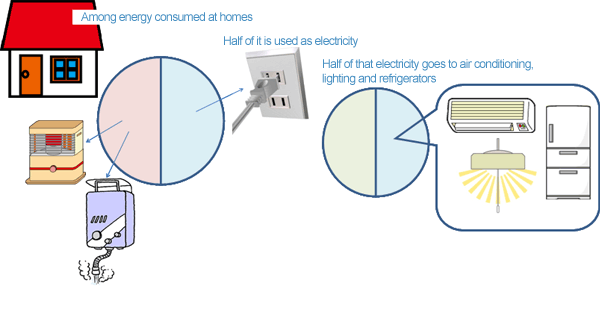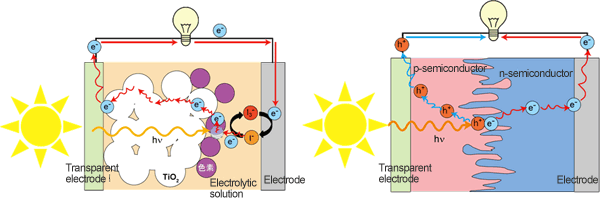Top>Research>Power problems and the development of a next-generation solar cell
 Index
Index

Kenji Katayama [profile]
Education Course
Power problems and the development of a next-generation solar cell
Kenji Katayama
Professor of Photochemistry and Spectroscopic Analytical Chemistry,
Faculty of Science and Engineering, Chuo University
1.Energy estimation
Even since the Great East Japan Earthquake and the Fukushima Daiichi nuclear disaster, there has been demand for securing alternative energy which will eliminate dependence on nuclear power. However, there are few people who possess a quantitative image for how much power is obtained from nuclear power and for the way in which that power is used. Personally, until considering this problem, I had not been aware of concepts such as energy consumption, utilizable energy, different types of power, and quantitative balance. Did you know that 40% of the power consumed in Japan is used for generating power? Were you aware that only about 40% of the power generated can be actually utilized? As a researcher of solar cells, I made a variety of calculations based on sources such as the Energy White Paper (homepage of the Ministry of Economy, Trade and Industry).
First, let's look at Figure 1, which shows energy reaching Japan from the sun.
揃Within all energy showered on the earth by sunlight, only 1% is utilizable energy.
揃The energy used by people throughout the world is only 1% to 2% of that utilizable energy.
揃Japan uses 4% of the world's total energy.
I'm sure that these numbers were smaller than you expected.

Figure 1: Image of distribution for energy from the sun
Next, let's look at Figure 2, which shows Japan's energy consumption balance.
揃40% of the total energy is used as electric power.
揃About 25% of electric power was expected to beprovided by nuclear power before the disaster.
揃About 200 nuclear reactors would be required to provide all of Japan's power through nuclear power (there are currently about 50 reactors).
揃Power is used in 3 almost equal parts by homes, companies and industry.
揃1 nuclear reactor provides power for approximately 500 thousand to 1 million homes.
揃Renewable energy accounts for only about 1% of power generated (equivalent to 1 nuclear reactor).
揃Solar power and wind power account for 10% of in the renewable energy.
This clearly shows the large amount of power generated through nuclear power, as well as the small amount of power currently generated through renewable energy.

Figure 2: Image of distribution for energy/power used in Japan
Finally, Figure 3 shows how energy is used at homes.
揃Half of energy is covered by electric power. The remainder is covered by gas and kerosene.
揃Air conditioning, lighting and refrigerators account for half of the power used at homes.
It seems that about one-third of power used at homes will still be consumed even if energy-saving measures are implemented. Please note that the numbers listed above are simplified in order to easily form an image of quantitative relationships, and that the numbers may be open to dispute as such.

Figure 3: Image of distribution for energy/power used at homes
These numbers show that a single nuclear reactor can supply electricity for homes in a city of 500 thousand to 1 million people. Furthermore, power demand in Japan is being fulfilled without operating hardly any of the 50 nuclear reactors which once supplied one-fourth of Japan's power. Currently, Japan is seeking to enact a difficult plan which involves covering this energy loss by using sunlight, wind power and other forms of renewable energy which only generates about one-tenth the power of a single nuclear reactor.
In this article, I will discuss the solar cells which we are researching. Only a mere 0.2% of power supplied is power obtained using sunlight. So, why are there such great expectations towards solar power? The answer is that the amount of solar energy reaching the earth is equivalent to 10,000 times the energy consumed by mankind.
2.Types of solar power
There are two types of solar power: solar thermal power and solar cells. Solar cells are familiar to people as the panels which are installed on the roofs of homes. These panels are based on silicon semiconductors known as pn-junctions. When light is shone on the panels, electricity (electrons) is generated. This electricity is then extracted for use. I am conducting research on a technology which is expected to become the next generation of this type of solar cells.
Solar thermal power is a type of solar power used by installing a large number of mirrors in an open area of land such as a desert. The light reflected by the mirrors is concentrated on a single point. A heating unit is installed at this point. The heating creates steam. The power of this steam is used to turn a turbine and generate power. After all this is the same form as thermal power and nuclear power, both of which use heated steam to turn a turbine and generate power. In the case of water power, the force of falling water is used to turn a turbine.
3.Supplying power through solar power
Is it really possible to supply the necessary amount of power through solar power? Let's consider supply using solar cells. Since solar cells are affected by the amount of sunlight, it is difficult to make an accurate calculation. For now, let's assume that about 30 nuclear reactors, namely 60% of Japan's total number of nuclear reactors, are operating. The amount of power generated by a single reactor is equivalent to solar cells installed on the roofs of 2 million homes. Thus, a simple calculation shows that it is necessary to install solar cells on the roofs of 60 million homes. There are 50 million homes in Japan, so it is impossible to cover all energy needs using solar power. Instead, I believe that it is best to consider the merits of having power generating facilities at each home from the perspective of risk management.
However, one technology used recently is mega-solar, which consists of a large number of solar cell panels being used on vacant land. Common mega-solar facilities are one-hundredth to one-thousandth the scale of a single nuclear reactor. Such mega-solar facilities can cover home power for a town of several thousand to ten thousand people. However, there are currently only about 100 such mega-solar facilities, so they aren't a feasible alternative to nuclear power. Still, such mega-solar facilities can be installed in an area equal to the size of several soccer fields, making them a sensible method for supply power to small towns outside of urban areas. Furthermore, SoftBank has recently announced the development of a giant mega-solar facility which is one-tenth the scale of a nuclear reactor. This would be an effective method for using idle land.
In any case, solar power alone is not a feasible alternative to nuclear power. It is necessary to consider an alternative method which combines a variety of energy sources.
4.Situation of development of solar cells
Still, an alternative energy source is needed, and some people might think that we just need to install solar cell panels on rooftops as fast as possible. However, if that were true, there would be no need for researchers like ourselves who develop next-generation solar cells. So, what is the problem? One material used in solar cell panels is silicon. When creating materials, it is necessary to make single crystals by melting the silicon through heating to a temperature of about 1500°C. Of course, fuel and electricity are needed to create such a high temperature. This creates a paradox in which more and more energy is consumed to manufacture more and more solar cells for the creation of energy. It is true that the consumed energy can be recovered if the solar cells are used to continually create electricity over a period of many years.
For that reason, there is currently demand for efficient solar cells without energy cost for manufacturing and with truly low energy loss. Two types of next-generation solar cells which are now attracting much attention are dye-sensitized solar cells and organic film solar cells. (Figure 4)

Figure 4: Next-generation solar cells: dye-sensitized solar cells (left) and organic film solar cells (right)
In the case of dye-sensitized solar cells, as implied by the name, dye is added. This dye creates electricity (electrons) by absorbing sunlight. The dyeing of the solar cells literally adds color. This dye has the property of absorbing a color which can be seen by the human eye, and the cells appear the color which is not being absorbed. Accordingly, it is best to use a variety of dye colors in order to absorb a variety of colors of solar energy. The manufacturing of dye-sensitized solar cells does not involve high temperatures or the creation of complicated devices. Actually, this kind of solar cell is often used at laboratories at junior high schools and high schools. (It is also possible to use dye after extracting it from the leaves of plants around us.) However, since dye-sensitized solar cells use electrochemical reactions and organic substances such as dyes, there is the problem of deterioration and sealing.
In the case of organic film solar cells, the solar cells which were previously made using silicon are now made entirely of organic substances. Earlier in this article, I stated that silicon solar cells use semiconductors known as pn-junctions. These pn-junctions are used in order to separate and carry electrons (negative electric charge) and holes (positive electric charge). By mixing different organic substances which carry electrons and holes, pn-junctions are made. Since the pn-junctions are made completely of organic substances, mass production is possible. Furthermore, the films are flexible and can be affixed to any shape of surface. However, as one would expect, durability is a problem as they are organic substances. I'm sure that many people have experienced how plastic gradually becomes fragile when exposed to sunlight. In the same way, solar cells made using organic substances undergo a certain amount of deterioration. Researchers are working to prevent this problem.
Currently, the efficiency (the amount of irradiated solar energy which can be converted into electricity) of silicon solar cells is just over 20%. In contrast, the efficiency of dye-sensitized solar cells and organic film solar cells is just over 10%. In the case of either technology, only about 10 to 20 years have passed since research began, so efficiency is increasing at an astounding speed. In the future, it is expected that further priority will be given to related research, that new types of solar cells will be developed, and that more efficient usage of natural energy will be achieved.
5.Conclusion
For researchers, the research funding received from the government and government institutions is our lifeline. Since the Great East Japan Earthquake, there has been an increase in researching emphasizing the development of alternative energy. Accordingly, there has been a rapid increase in researchers conducting research in line with that goal. I am one of those researchers. I believe that an increase in researchers conducting research in line with national policy is beneficial for national strategy. However, the development of alternative energy cannot be accelerated simply by pouring more money into the field.
Research and development always takes time. It is difficult to explain the reason to people who have never actually conducted R&D. In some cases, research proceeds in relation to the effort (budget) which is put into the research. In other cases, research success is realized by trying a wide variety of things and being lucky. Considering the amount of power currently covered by solar cells, it seems that a major innovation realized through "luck" is now required for the development of solar cells. Such research is similar to playing the lottery; spending a lot of money will increase your chances of hitting the jackpot, but there it is still possible that you will never win. Solar cells are such a technology, so it would be irresponsible to proclaim that they can serve as an alternative to nuclear power.
Another argument that can be heard is that there is sufficient electricity even if nuclear power plants are stopped. However, according to what I heard from an acquaintance of mine, thermal power plants were built at a normally unbelievable speed after the Fukushima Daiichi nuclear disaster. Instead of simply believing that there is sufficient electricity, it would be best to realize that extreme measures are being taken to ensure sufficient electricity. There are many outstanding researchers and engineers in power companies and other related companies. Recognition should be given to the efforts of such people. Furthermore, if it is acceptable to produce sufficient electricity through burning at thermal power plants, then what was the point of all the debate regarding carbon dioxide emissions? If we are going to stop using nuclear power completely, each person must have the conviction to save the 20% to 30% of their power which had been supplied through nuclear power. This means being prepared to stop using air conditioning and stop turning on the television. Personally, I believe that the appropriate course of action for a mature advanced nation is moving towards the reduction of nuclear power plants while each citizen fulfills their personal responsibility of energy saving.
I was asked to write this article in the midst of the Lower House elections. The future of nuclear power was a point of dispute in the election. Around the time that this article is published, we should have a clear understanding of how citizens view the energy/power problem.
- Kenji Katayama
Professor of Photochemistry and Spectroscopic Analytical Chemistry,
Faculty of Science and Engineering, Chuo University -
Born in Kagawa Prefecture in 1973. In 1996, graduated from the Faculty of Engineering, University of Tokyo. In 1999, withdrew from the Doctoral Program at the University of Tokyo Graduate School. Holds a PhD in engineering from the University of Tokyo. Served as a Research Associate at the University of Tokyo, as a Postdoctoral Fellow at the Massachusetts Institute of Technology, and as a Researcher at the Kanagawa Academy of Science and Technology. In 2006, became an Associate Professor at the Department of Applied Chemistry in the Faculty of Science and Engineering, Chuo University. In 2012, appointed as Professor in the same department. Develops new spectroscopic analysis methods using laser light sources and conducts evaluation of various materials such as solar cells, photocatalysts, polymer molecules and liquid crystal. Also is developing a new chemistry experiment educational method using small instruments and small amounts of reagents.
Homepage: http://www.chem.chuo-u.ac.jp/~spec/index_e.html
- Research Activities as a Member of Research Fellowship for Young Scientists (DC1), Japan Society for the Promotion of Science (JSPS) Shuma Tsurumi
- Important Factors for Innovation in Payment Services Nobuhiko Sugiura
- Beyond the Concepts of Fellow Citizens and Foreigners— To Achieve SDGs Goal 10 “Reduce Inequality Within and Among Countries” Rika Lee
- Diary of Struggles in Cambodia Fumie Fukuoka
- How Can We Measure Learning Ability?
—Analysis of a Competency Self-Assessment Questionnaire— Yu Saito / Yoko Neha - The Making of the Movie Kirakira Megane








